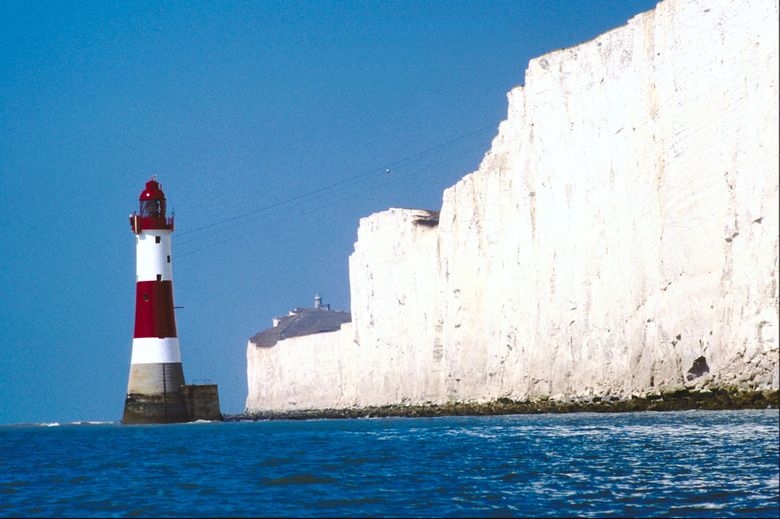Organic Sedimentary Vs. Chemical Sedimentary Rock
How are organically formed sedimentary rocks different from chemically formed sedimentary rocks? As a review, sedimentary rocks are one of three main rock types; the other two are igneous and metamorphic. Sedimentary rocks are formed through the accumulation of sediment over long periods of time – often hundreds of millions of years. Chemical sedimentary rocks are composed of non-organic materials that precipitate from water, whereas organic sedimentary rocks are made of materials that consist mainly of carbon that was once part of a living organism. While the process of formation for organic and chemical sedimentary rocks is similar, these two types of rocks differ in composition and texture.
Chemical and Organic Sedimentary Rocks
Chemical and Organic Sedimentary Rocks
In nature, some sedimentary rocks are composed of both chemical and organic materials. This often occurs near bodies of water, where the the accumulation of both chemical precipitates and organic materials creates unique sedimentary rocks.
For example, the combination of calcite-rich mud and fossils creates a sedimentary rock known as fossiliferous limestone. Limestone is an interesting sedimentary rock, as it can be of chemical or organic nature – or a combination of both. The line between chemical and organic sedimentary rocks is sometimes blurry, and while it may be difficult for a novice to determine the exact nature of some sedimentary rocks, expert geologists can tell the difference by examining the texture and chemical composition of the rocks.
Sedimentary rocks – whether chemical or organic – tend to form in similar environments, due to the way in which they are created, through the accumulation of sediment over many years. These areas are referred to as sedimentary environments, and they are often places where land meets water. Typical sedimentary environments include sand dunes, alluvial fans, deltas and beaches.
Examples of Organic Sedimentary Rocks
Examples of Organic Sedimentary Rocks
Some of our most important fossil fuel sources are actually organic sedimentary rocks, which are sometimes referred to as biological sedimentary rocks. Coal, lignite coal, bituminous coal and anthracite are all examples of high-carbon organic sedimentary rocks, made up of materials that were once part of living organisms.
Formed over millions of years, the different types of coal usually form in anaerobic environments like swamps, wetlands and bogs. Consisting of plant material that has accumulated and decomposed, some types of coal, like anthracite, contain as much as 97% carbon.
Considered non-renewable energy sources due to the fact that they take hundred of millions of years to form, organic sedimentary rocks like coal and anthracite contribute significantly to greenhouse gas emissions when they are burned.
Other organic sedimentary rocks, like biochemical limestone and biochemical chert, are formed through the accumulation of organic materials like the shells of diatoms and corals. Organic sedimentary rocks may be coarse in texture, as opposed to chemical sedimentary rocks, as they often contain plant and animal materials.
Examples of Chemical Sedimentary Rocks
Examples of Chemical Sedimentary Rocks
Many chemical sedimentary rocks are carbonates, which contain high concentrations of calcium. Other sedimentary minerals are evaporates, meaning that they precipitate when salt or fresh water evaporates due to changes in temperature. Chemical sedimentary rocks are typically crystalline in texture and composed of one type of mineral, which sets them apart from organic sedimentary rocks.
Some examples of chemical sedimentary rocks are chemical limestones, travertine, dolostones and cherts. Cherts are sedimentary rocks that are high in silica, often of distinctive colors. Flint, jasper and agate are examples of cherts.
Many of these rocks are formed when water cools or evaporates, causing the precipitation of minerals that were dissolved in the water. With distinctive colors and textures, the hundreds of kinds of chemical sedimentary rocks are distinguished by the geological words that have been established to help identify and describe their unique hues and features.
Cite This Article
MLA
Sloane, Christina. "Organic Sedimentary Vs. Chemical Sedimentary Rock" sciencing.com, https://www.sciencing.com/organic-sedimentary-vs-chemical-sedimentary-rock-5124/. 18 January 2022.
APA
Sloane, Christina. (2022, January 18). Organic Sedimentary Vs. Chemical Sedimentary Rock. sciencing.com. Retrieved from https://www.sciencing.com/organic-sedimentary-vs-chemical-sedimentary-rock-5124/
Chicago
Sloane, Christina. Organic Sedimentary Vs. Chemical Sedimentary Rock last modified August 30, 2022. https://www.sciencing.com/organic-sedimentary-vs-chemical-sedimentary-rock-5124/
